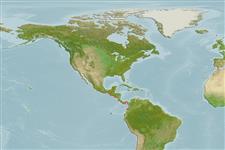>
Carangaria/misc (Various families in series Carangaria) >
Centropomidae (Snooks)
Etymology: Centropomus: Greek, kentron = sting + Greek, poma, -atos = cover, operculum (Ref. 45335).
More on author: Gill.
Environment: milieu / climate zone / depth range / distribution range
Ökologie
seewasser; brackwasser demersal. Tropical; 24°N - 4°S, 107°W - 76°W
Eastern Pacific: Mexico to Ecuador.
Size / Gewicht / Alter
Maturity: Lm ? range ? - ? cm
Max length : 46.5 cm TL Männchen/unbestimmt; (Ref. 124487); common length : 25.0 cm TL Männchen/unbestimmt; (Ref. 55763); max. veröff. Gewicht: 1.0 kg (Ref. 124487)
Body long and moderately deep; dorsal profile slightly concave behind the eyes; lateral line extending to posterior edge of caudal fin; second anal spine, when folded-down, reaching or surpassing origin of caudal fin; pectoral and pelvic fins sub-equal; first gill arch with 20 to 25 gill rakers; back blue gray; belly silvery; lateral line dark; membranes between spines of first dorsal fin and between second and third anal spines black (Ref. 55763)
Life cycle and mating behavior
Maturities | Fortpflanzung | Spawnings | Egg(s) | Fecundities | Larven
Bussing, W.A., 1995. Centropomidae. Róbalos. p. 987-995. In W. Fischer, F. Krupp, W. Schneider, C. Sommer, K.E. Carpenter and V. Niem (eds.) Guia FAO para Identification de Especies para lo Fines de la Pesca. Pacifico Centro-Oriental. 3 Vols. FAO, Rome. (Ref. 9284)
IUCN Rote Liste Status (Ref. 130435)
Bedrohung für Menschen
Harmless
Nutzung durch Menschen
Fischereien: kommerziell; Sportfisch: ja
Tools
Zusatzinformationen
Download XML
Internet Quellen
Estimates based on models
Preferred temperature (Ref.
123201): 26.8 - 29.1, mean 28.2 °C (based on 129 cells).
Phylogenetic diversity index (Ref.
82804): PD
50 = 0.5005 [Uniqueness, from 0.5 = low to 2.0 = high].
Bayesian length-weight: a=0.00708 (0.00414 - 0.01211), b=3.10 (2.95 - 3.25), in cm total length, based on LWR estimates for this species & Genus-body shape (Ref.
93245).
Trophic level (Ref.
69278): 3.9 ±0.7 se; based on size and trophs of closest relatives
Generation time: 2.7 ( na - na) years. Estimated as median ln(3)/K based on 1
growth studies.
Widerstandsfähigkeit (Ref.
120179): mittel, Verdopplung der Population dauert 1,4 - 4,4 Jahre. (Preliminary K or Fecundity.).
Fishing Vulnerability (Ref.
59153): Low to moderate vulnerability (31 of 100).
Nutrients (Ref.
124155): Calcium = 155 [86, 250] mg/100g; Iron = 1.07 [0.72, 1.62] mg/100g; Protein = 19.3 [17.0, 21.5] %; Omega3 = 0.277 [0.125, 0.615] g/100g; Selenium = 37.9 [20.9, 70.5] μg/100g; VitaminA = 22.1 [9.0, 53.2] μg/100g; Zinc = 1.21 [0.92, 1.65] mg/100g (wet weight);
